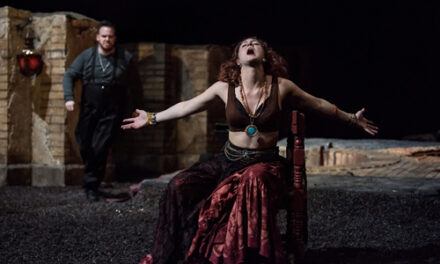The Raleigh Symphony Orchestra, now 34 years of age, has a new look, shape, feel, and sound (and a new website, too). I think it’s safe to say the ensemble has never been in better shape, artistically – that claim stemming from a long-time observer who perceives that it is our community orchestras and choirs that provide the beating hearts and souls of our musical lives. The RSO has long existed in the shadow of the far-better-funded NC Symphony, so even its identity has been a challenge – put “Raleigh Symphony” in Google and the first thing that pops up is an ad for the other one! But things are changing, so now, when someone in the capital refers to “The Symphony,” it’s wise to ask, “Which one?”
The RSO has a small group of loyal supporters, stable management, and a solid relationship with an academic institution that comes with access to several good performance spaces. It is, as someone said, lean. Never mean. Hungry? Maybe.
Best of all, it has a fairly new artistic director who is proving to be a first-rate orchestra builder, a master program-maker, and a very commendable conductor who is working wonders with the assets – fiscal and artistic – available to him. He got to work for a while with Alan Neilson, his predecessor, so there was a sense of transition in the way the reins were passed. He is a cellist, and a good one, to boot. Jim Waddelow is his name. Make note of it – and of him. He and his orchestra are worth a listen or two or three.
The opening concert of the current season amply demonstrated the orchestra’s present maturity, skill, resourcefulness, and resiliency, too, as the program went through several fairly last-minute changes. A soloist fell victim to allergies, so a major American work (Barber’s Knoxville: Summer of 1915) was postponed till next April. In its place came Haydn’s “Hen” Symphony, a brave substitution indeed, for Haydn is never easy, even for some full-time professional bands. But this in turn allowed the other American work on the program, the premiere of Bill Robinson‘s fascinating Violations [yes!], to move up to the top of the opening half. And in the second, all-Beethoven half, there came the Fidelio Overture and the superb local artist-teacher Karen Allred as soloist in the First Piano Concerto. The RSO has long played Beethoven as if its life depended on it – and perhaps it does. For sure, none of these works brought anything but pleasure.
Robinson is a composer who moonlights as a physicist, or maybe that should be the other way around. His scores are often unusual, sometimes setting languages one would never suspect, at other times bearing wry tempo indications or other annotations. Violations is for string orchestra, with subdivided parts. It will be played by a consort of viols – hence the name – on February 9, at UNC. Its four movements bear these markings: “Finis Origine Pendet” (“The end depends on the beginning”), “With Vigor,” “Largo Lacrimoso,” and “Allegro landini.” None of these is critical to enjoying or understanding the music, which has a certain air about it – an air of nostalgia, reminiscent of some of the great English (or, if you prefer, early American) works (from New England, specifically) for string orchestra – think Vaughan Williams with some added spice, mixed with a dash of William Billings, minus the hymn tunes.
The performance was remarkably fine. It was so fine it gave pause. The strings of the RSO have been transformed under Waddelow. Even the smallish groupings that resulted from those subdivisions were strong, unified, and precise. The music is engaging, and it will be great fun to hear it again in February, when the sound will be radically different, to be sure. But here, in Meredith’s Jones Auditorium, the strings did the work and its composer proud, and the results elicited warm applause.
Haydn’s Symphony No. 83 evokes chicken sounds – hence its nickname. But the players were bold and assured, and the work emerged as a radiant, tightly-unified example of classical symphonic writing at its best, admirably served. An orchestra that plays Haydn this well is an orchestra worth hearing,
Post intermission came the Fidelio Overture, crisply realized and a pleasure to experience. The horns seemed unhappy at the start but recovered fully by mid-stream. The overture served as a fine introduction to what became the afternoon’s pièce de résistance, Beethoven’s Piano Concerto No. 1 in C, Op. 15 (which is really No. 2 in terms of its chronology…). Karen Allred, one of our region’s finest and most thoughtful keyboard artists, was the distinguished soloist. That she and the conductor were operating on the same wave-length was evident from the outset. It’s familiar fare, of course, but how could one ever tire of hearing it, especially when played with such compelling unanimity? The brisk opening and closing movements were bright and exciting, and the slow one was beautifully realized, its long phrases lovingly conveyed by all concerned at a pace that almost made one think that time was standing still. (The cadenzas were by Beethoven.)
The crowd seemed to want an encore and enough flowers were presented to have resulted in one, but instead folks had to make do with a reception, which we understand was nicely realized, too.
For more information on future RSO concerts, see our calendar.
PS The orchestra is partnering with other non-profits to help advance collective causes. This time lobby tables featured the Boys and Girls Clubs, Saving Grace, and the Wounded Warrior Project.











